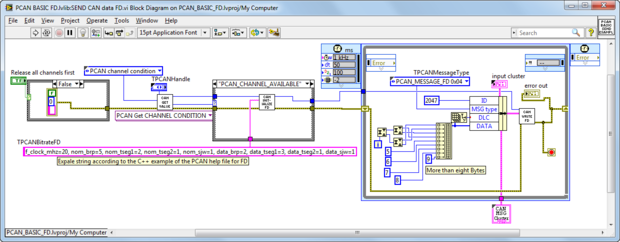
LabVIEW Driver for PCAN-Basic 4.x
The LabVIEW driver for PCAN-Basic 4.x simplifies hardware integration and speeds up development. The LabVIEW API works with the PCAN Basic 4.0 API to send and receive CAN messages through PCAN hardware, supporting CAN 1.0/2.0B and CAN FD protocols. The LabVIEW driver integrates with your existing software seamlessly, supporting LabVIEW 2014 or higher.
- No familiarization time, since C header files (*.h) no longer need to be read and so the associated DLL calls are no longer required
- For these drivers interface cards and adapters are available that are all operated with the same calls (parallel, ISA, PCI, PC-104, USB etc.)
- Simplified configuration in LabView via the functions Create-control or Create-constant
Delivery Contents:
- The LabView drivers are digitally delivered with an e-mail. Therefore, please enter the e-mail address of the intended recipient in the delivery address or in the comments when ordering.
- Documentation in PDF format
| Users manual |
| User's Manual in English |
Enjoy Expert Technical Support from Phytools
At Phytools we have provided advanced networking solutions for almost 30 years and our commitment to service excellence is unmatched. Contact our experts if you require support before, during, or after your purchase.
LabVIEW Driver FAQs
What are the key benefits of LabVIEW drivers?
This powerful API simplifies hardware communication by providing pre-built functions and examples. Ready-made VIs reduce development time significantly. The LabVIEW driver for PCAN-Basic 4.x can be customized to meet the needs of your project and built-in error reporting makes troubleshooting hardware communications easier.
How will I receive the LabVIEW driver?
You will receive the LabVIEW driver digitally via email and its documentation in a PDF format. Please supply the email address to which you want to receive the API in the comments section of the order page.
In which applications is the LabVIEW driver useful?
The LabVIEW driver for PCAN-Basic 4.x is versatile and may be used in a number of applications including:
- Automotive testing - Test ECUs or monitor CAN bus data for diagnostics.
- Industrial automation - Monitor factory equipment such as motors, sensors, and belts.
- Renewable energy systems - Monitor and control energy systems such as solar inverters.
- Research and development - Prototype and test new technologies.
- Medical devices - Develop and test communication for devices such as ventilators.
- Aerospace and defence - Simulate and validate avionics systems.
How do I use the LabVIEW driver?
First, ensure the PCAN hardware and drivers are installed. Then import the LabVIEW driver into your LabVIEW environment. Use the pre-built VIs or develop your own to interact with the CAN bus. Finally, test your application to ensure reliable communication with CAN devices.
Where are LabVIEW drivers stored?
LabVIEW stores instrument driver files in the labview\instr.lib directory. You can access the installed instrument driver VIs through the Instrument Drivers palette in LabVIEW.
Can I use multiple PCAN devices simultaneously?
Yes, the driver supports multiple PCAN hardware devices - up to 8 CAN 2.0B devices and up to 8 CAN-FD devices. Each device can be assigned a unique channel for communication with up to 16 nets and one client per net.



